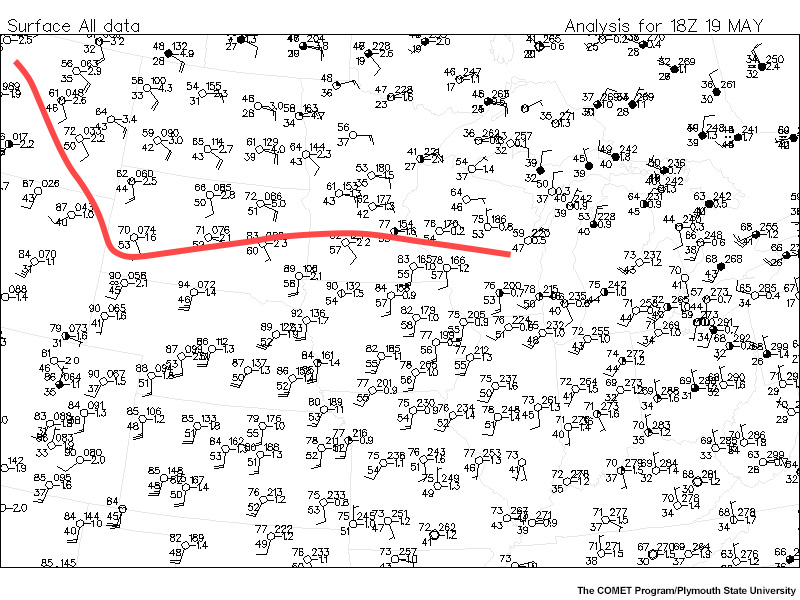Pre-Lab: Finding Fronts using Multiple Fields » Supporting Observations: Radar, Satellite and Other Fields
As we saw earlier, using surface observation plots is a relatively comprehensive way of detailing the positions of surface fronts. However, frontal location can be pinpointed even more accurately with assistance of radar and satellite data. The resolution of such products is much higher than station plots, which are often spaced sparsely, being tens of miles apart. Additionally, many reporting stations only report hourly, and those that report more frequently sometimes do not get pulled into standard hourly maps, while radars scan low levels approximately every 5 minutes and geostationary satellite data is updated every 15 minutes (soon to be 1 to 5 minutes with GOES-R).
Timely and detailed frontal positioning information can be critical during short-term forecasts of severe convection, high winds, mixed precipitation and is thus especially important to industries like aviation.
Here we will see a couple examples of how a synoptic-scale front can appear on radar. First, let’s look at the warm front example we analyzed earlier:

The warm front runs roughly from the intersection of MT, WY and SD southeastward through southern SD, eastward and northeastward into the Minneapolis area, and then through central WI - further east than this the boundary may be stationary, given the more variable and lighter winds.
Because the observations are relatively sparse, we could see more detail if the local radar happened to capture it well. Here’s a loop of the MPX radar base reflectivity centered on the same time as the surface analysis (Chanhanssen, Minnesota - just south and east of Minneapolis)
Another example of using local radar to help refine frontal position is below. A dryline is present as a fineline moving toward the east - and eventually initiates convection.
Finally, satellite is also an important tool to refine frontal locations and helps provide a wider perspective on frontal locations within cyclones. While we saw earlier that cloud cover itself often does not align with frontal locations, and is usually more widespread, certain types of cloud patterns on visible and infrared imagery, such as thin lines of very thick clouds along cold fronts, can help determine frontal location. Furthermore, water vapor imagery can be used to help diagnose both surface and upper level fronts, as seen in the loop below.
Two distinct lines of convection develop throughout the course of the animation - one along and just ahead of the first cold front (which in this case, has properties making it appear similar to a dryline - this previously cooler air came from the Pacific but has been modified by downsloping, warm ground and solar insolation), and another along a secondary cold front that trails it. In the water vapor image we can see two distinct deformation zones that align with these convective features. Much drier air is present at low-mid levels behind the second deformation zone especially. In the radar image, we can even see evidence of the location of the secondary cold front in clear air across several stations near the panhandles of Texas and Oklahoma, and stretching eastward slightly into Kansas and westward just into New Mexico - this fineline is most pronounced at 20Z and looks like an thin arc of light blue/gray pushing southward over time.